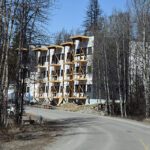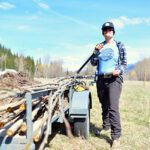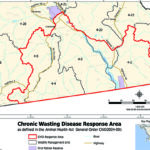Home »

Province steps up to help conclude purchase of hovercraft
Lake Windermere and other bodies of water in the Columbia Valley are popular four-season recreation hot spots.
 As a result, safety continues to be a concern as large numbers of people spread out over the lakes and when something goes wrong, rescue efforts can take time and seconds and minutes equate to life or death in such situations.
As a result, safety continues to be a concern as large numbers of people spread out over the lakes and when something goes wrong, rescue efforts can take time and seconds and minutes equate to life or death in such situations.
With a past winter rescue on Lake Windermere as a backdrop, Minister of Community, Sport and Cultural Development Bill Bennett (Kootenay East MLA) presented the Kinsmen Club of Windermere Valley through to the Columbia Valley Rural Fire and Rescue Services (CVRFRS) with a $65,000 cheque March 26 during a brief ceremony at the Windermere Fire Hall. The money will be used to conclude the purchase of a rescue hovercraft that will be available for use throughout the Columbia Valley.
Spearheading the push for the purchase of a hovercraft is Lake Windermere Ambassadors vice-chair Danny Osbourne, who experienced a serious winter rescue on Lake Windermere, by CVRFRS members.
He related his story to a gathering of firefighters and Columbia Valley VIPs, including Regional District of East Kootenay Electoral Area F director Wendy Booth, Village of Radium Hot Springs Mayor Dee Conklin, Chamber of Commerce directors, Columbia River-Revelstoke Liberal candidate Doug Clovechok and members of the Kinsmen Club, which received the government funds as a non-profit organization on behalf of the CVRFRS and then handed them over.

On December 27, 2011, Osbourne said he “stood on this very spot and thanked you and you and you and members of Jim’s team (CVRFRS Chief Jim Miller) for saving the life of my son-in-law on Lake Windermere, on a cold, windy, snowy Boxing Day night when everybody at our home was waiting for John to come back and have a wonderful time and somebody knocked on the door and none of us want to have that knock on the door in our lives. But the knock on the door came and it was “John’s in trouble on the lake, it’s serious and you need to call 9-1-1.”
Osbourne related after arriving at the scene on the lake, he found that John’s ATV had gone through tie ice into the water and his son-in-law had been thrown across the ice.
He had suffered a punctured lung, multiple cracked vertebrae and several broken ribs and lacerations “and was thought to have a negative heart issue as a by-product of this incident,” he said, adding, “Bottom line is he survived and we’re very grateful.
I came here the next day to thank everybody for saving his life.”
Osbourne said the incident was made all-the-more-harrowing because of the amount of time it took for the rescue to develop because of the darkness.
“We were suffering through those moments of agony where you know that help is on the way but you don’t know when it is going to arrive,” he said. Eventually, the rescue party appeared moving through the darkness across the ice.
“We were certainly very grateful to see them coming. But I wasn’t expecting to see them walking to the scene. There was a waiting ambulance on shore.”
Osbourne said “the net of it” is the rescue team and BC Ambulance could not head onto the ice in their vehicles because of the uncertain nature of the ice and after his son-in-law’s health issues were improving, he began thinking about what could be done to improve rescue times on Lake Windermere.
 “The solution was one that Jim (Miller) had envisioned for some time. And one I offered to help him with. We set about to secure the right solution that would meet the minimum requirements without being extravagant. It led to us developing some community support in the form of encouragement and financial support. I partnered with the chamber, who are promoting the WhiteWay and have a vested interest to make sure there is infrastructure in place in the event of issues on the lake.”
“The solution was one that Jim (Miller) had envisioned for some time. And one I offered to help him with. We set about to secure the right solution that would meet the minimum requirements without being extravagant. It led to us developing some community support in the form of encouragement and financial support. I partnered with the chamber, who are promoting the WhiteWay and have a vested interest to make sure there is infrastructure in place in the event of issues on the lake.”
Osbourne thanked Bennett for “a very significant contribution” to the Columbia Valley community.
“We’re talking here about an environmentally-friendly, life saving solution. Its benefits are countless.”
Bennett said one of the “pleasures” of being in his ministerial portfolio is being able to hand out Community Gaming Grant funds.
The funds benefit a wide array of community groups and organizations throughout the province that bolster social, sports, culture and safety programs.
“All of those non-profit groups in the province benefit from the program,” he said.
Bennett said he became aware of the need after a call from Clovechok, who said “something to the effect of ‘hey, can you find some money to get a hovercraft for the firefighters in Invermere and Windermere. I thought, ‘a hovercraft? That’s an odd request. I don’t think I’ve ever had that one before.’ So, we put it in the hopper; I asked my staff to start looking into it and then the professional people in the ministry who evaluate these applications. They talked to the folks here enough to know that it looked like a very sincere and important need in this community; something we ought to do if we can.”
Bennett also noted that the ministry staff took the application a step further, which isn’t a common thing. He explained that the request was for $50,000 but ministry staff recognized that training would be required for operation of the hovercraft and an additional $15,000 was added to the final sum.
Along with the provincial government funding, Bennett credited other project backers including the District of Invermere, RDEK Areas F and G, local businesses and individuals who have donated money, including First Nations.
“Somebody else stopped by from the community and just put a thousand bucks into this just recently,” he exclaimed.
Fire Chief Miller said the acquisition of a hovercraft will “allow us to quickly and safely reach any victim or patient anywhere on the lake, within the golden hour of survival.”
The department has “been doing ice rescue and training and rescues – quite a few of them since we started actually – for about 11 or 12 years,” he said. “Right from the get-go, when we first took it on, we saw it as a good thing with a great need and the potential is huge – with more and more people using the lake, not to mention the vehicles that drive across between Invermere and Windermere that at one time was a road used constantly but not so much any more because the ice is so unpredictable now,” Miller said, explaining that while the department moved forward with covering the lake for rescues, he developed “a real pet peeve.”
Recognizing that “if we have to walk to the other side of the lake in the middle of the night, which has happened, trying to find somebody who is lost, the fear was that they went through and we’re on foot… you know I can’t take a vehicle on there. It’s not our policy to do so. What good is an ATV or a snowmobile because they can go through too, because of the weight and so forth?”
And that is when the concept of a hovercraft began to unfold.
“I got a lot of funny looks and people kind of snickered at that. A hovercraft back then was something fairly new to the industry. It was unproven but the concept was unbelievably fantastic,” Miller said, noting it took “a number of years just to get buy in on the idea.”
He said he trained with a friend who owns a personal hovercraft and he borrowed it “just to prove that I wasn’t blowing a bunch of wind” on the idea. “It worked fantastic. This particular machine is similar but a little bit bigger for rescue.”
In closing, Osbourne said the hovercraft will be deployed from the Windermere Fire Hall but will be available for use throughout the Columbia Valley.
“This is going to be extremely valuable in the (Columbia River) wetlands,” he said.
Ian Cobb/e-KNOW







